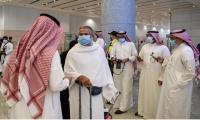KARACHI: The State Bank of Pakistan (SBP) on Tuesday tied growth outcome to the government’s response to the second wave of novel coronavirus after the economic recovery from the first upset that it says was overcome because of support to business activities.
“… the overall growth outcome hinges on how the Covid infections and the associated government response evolve,” the SBP said in the first quarterly report on the state of Pakistan’s economy.
Real GDP growth is projected to be in the range of 1.5 to 2.5 percent in FY2021 compared to 0.4 percent contraction in FY2020. The projection is based on the current trends of economic activity.
The SBP said the government’s handling of the current surge in Covid infections includes keeping of business activities running under standard operating procedures, thereby supporting economic activity and employment. The restrictions are focused more on reduced public gatherings, provisions for staff to work from home, and temporary closure of educational institutes.
“As the economy recovers from the Covid-induced contraction, it is now faced with uncertainty related to intensification of the second wave of the pandemic. This concern poses both upside and downside risks to the SBP’s macroeconomic projections,” it said.
Covid, which has swept across many countries and, in Pakistan’s case, gained momentum in November 2020. Supply-side shocks from uncertain weather conditions cannot be ruled out either. At the same time, there are also potential upsides. These include the development and distribution of an effective vaccine and its possible early availability. The announced increase in the wheat support price and subsidies on fertilizer and pesticides may contribute to a better than expected out-turn of Rabi crops.
The outlook for the external sector has improved since the previous set of projections published in SBP’s FY20 annual report. The current account deficit is now projected to be in the range of 0.5-1.5 percent of GDP as against earlier 1 to 2 percent of GDP. The revision is mainly due to an upward adjustment in workers’ remittances, which are now expected to be in $24-25 billion as compared to $22-23 billion.
“However, projections of workers’ remittances are subject to risk from the outlook for the oil-exporting economies, whose fiscal balances might deteriorate further with the escalation in global Covid infections. This may translate into a sizable reduction in their demand for foreign workers, leading to lower remittance inflows to Pakistan,” said the SBP.
The SBP said the outlook of exports and imports largely remains unchanged from their earlier assessment. The greater quantum of high value added textiles and food commodities – especially rice – are expected to generate above target growth in exports. That said the key downside risk to this outlook stems from the resurgence of Covid in major export destinations of Pakistan, which has the potential to suppress demand.
On the upside, the incentives given in the industrial support package since early November 2020 may help the textile sector exports perform better. Similarly, imports are projected to surpass their annual target. The increase in food imports and domestic economic activity is mainly expected to drive import growth.
The increase in global Covid infections and associated further decline in crude oil price could lower import payments.
As for the fiscal deficit, the latest projections suggest that it remains on track to meet the annual target of 7 percent of GDP.
“Going forward, the fiscal situation would continue to depend on the domestic evolution of Covid. The upside risks mainly stem from the health fallout, and the potential economic fall-out, in case of protracted or intensified lockdowns in the remainder of FY21,” said the SBP. “By contrast, faster than anticipated economic revival, which gives the government room to generate more revenues, either by rolling back certain tax concessions or imposing fresh levies, could contain the deficit further.”
The SBP projects average inflation in FY21 to remain in the 7 – 9 percent range. Food inflation, triggered by supply side factors, has been driving up headline inflation recently. Meanwhile, core inflation has been relatively moderate, owing to benign cost and demand factors. Given the spare capacity in the industrial sector, high base effect, and actions being taken to correct the supply side issues in the food market, upside risks to the inflation outlook are largely contained.
The headquarters of the Sui Southern Gas Company . — APP FileKARACHI: Sui Southern Gas Company has launched a fresh...
The logo of the ExpoMed Eurasia. — CA MI websiteKARACHI: Pakistan is participating in ExpoMed Eurasia, a leading...
Gold bars are seen in this undated file photo. — AFP/FileKARACHI: Gold prices increased by Rs500 per tola on...
FFBL Head Office building can be seen in Islamabad. — FFBL WebsiteKARACHI: Fauji Fertilizer Bin Qasim Limited has...
Representational file of an BMW car. — AFP FileLAHORE: Small improvements in economic credentials of the country are...
A fuel station worker filling petrol in vehicle at a fuel station in Karachi on Tuesday, April 16, 2024KARACHI: After...







